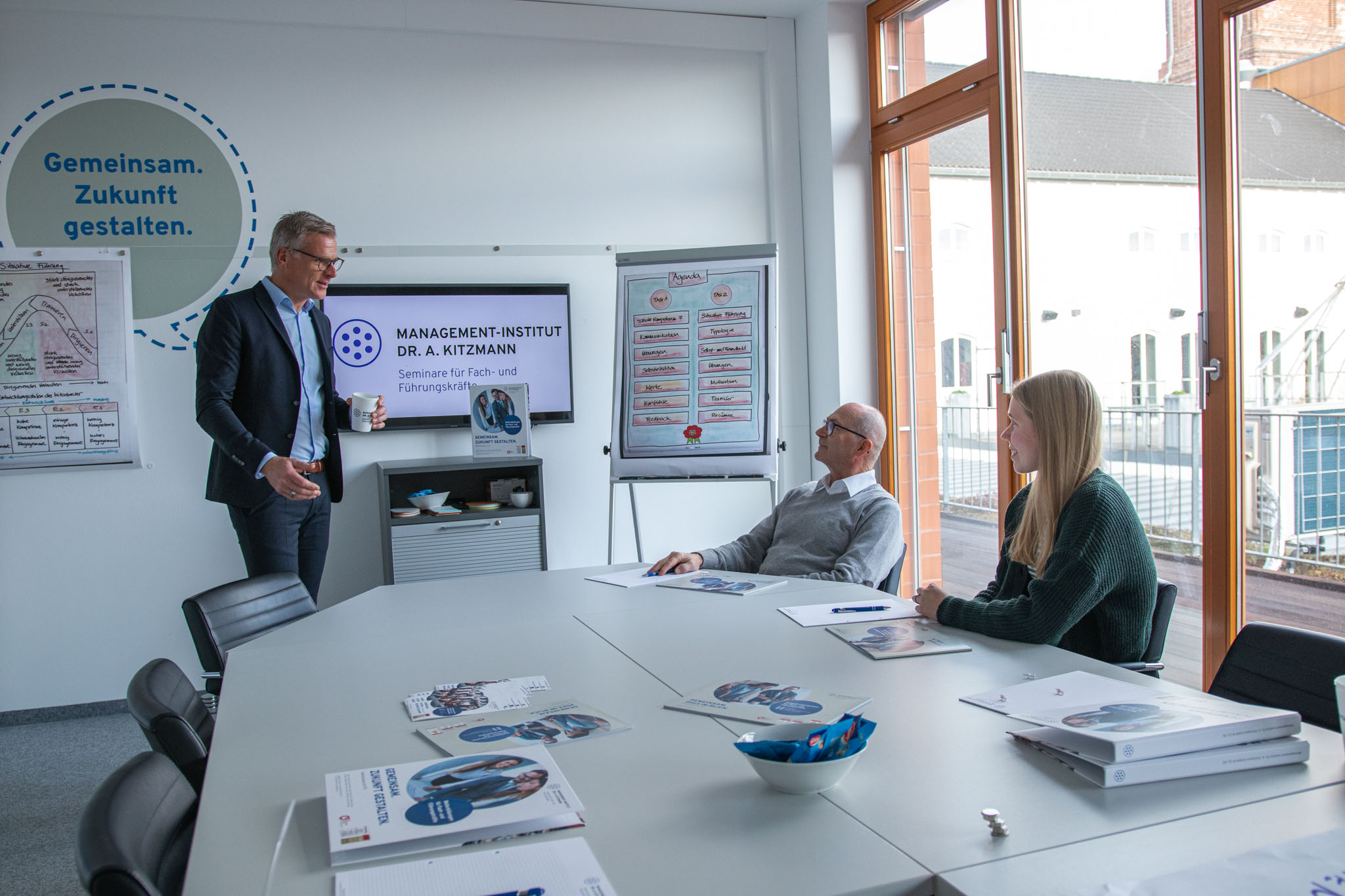
Conducting Difficult Employee Conversations: Guide with Examples

Difficult employee conversations are an uncomfortable but inevitable part of managing a team. A well-conducted conversation can help clarify misunderstandings, correct behaviors, and improve collaboration within the team. In this guide, you will learn how to properly prepare for, structure, and successfully conduct such conversations.
What Are Difficult Employee Conversations?
Difficult employee conversations can occur in everyday work in various forms. They often involve unpleasant topics or require difficult decisions that affect both the employee’s professional performance and personal behavior. Difficult conversations can have significant consequences for the employee, such as disciplinary measures or, in the worst case, termination.
Types of Difficult Employee Conversations
There are many occasions for a difficult employee conversation. Often, it involves one of the following topics:
- An absence conversation is conducted when an employee is frequently absent. The conversation is used to clarify the reasons for frequent or prolonged absences. Joint solutions are developed to improve the employee’s attendance.
- A disciplinary conversation is about directly addressing identified misconduct or performance deficiencies and making the consequences clear.
- A termination conversation is a conversation in which the manager informs the employee of the decision to terminate the employment relationship. The reasons for the termination are explained, the employee’s questions are answered, and arrangements for the transition are made. Termination should always be the last resort. Other conversations and warnings should have taken place beforehand.
Why You Should Not Postpone Difficult Conversations
Postponing difficult conversations often exacerbates the problems. When issues are not addressed immediately, they can escalate and strain the relationship between manager and employee. Delayed conversations often lead to misunderstandings and dissatisfaction, which can negatively impact the working atmosphere. Early clarification, on the other hand, enables constructive solutions and prevents conflicts and problems from growing.
Guide for Difficult Employee Conversations
This guide helps you plan and structure difficult employee conversations properly. A successful conversation is based on thorough preparation, a planned conversation structure, and careful follow-up.
Preparation
Thorough preparation is key to a successful conversation. Gather all relevant information and examples of the employee’s misconduct or poor performance. Make sure you comply with company policies and legal requirements.
To be well prepared, you should be aware of the following potential challenges in advance:
- Sometimes employees tend to hide the real reasons for their (mis)behavior. This can affect the effectiveness of the conversation because it makes it harder to identify the causes.
- Many employees hesitate to address conflicts with their manager. As a manager, it is your responsibility to approach the employee and address problems directly.
- Poor communication can quickly lead to misunderstandings. Therefore, make sure your feedback is clear and supported by facts.
- Without a thorough analysis of the reasons behind the employee’s behavior, the conversation often remains superficial, and the problem cannot be solved. Before the conversation, gather information and observe the employee’s behavior.
- Depending on the topic of the conversation, the employee may react emotionally, from anger to disappointment to sadness. Be prepared to respond empathetically and respectfully.
- For sensitive conversations such as termination, it is important to be aware of legal requirements. If necessary, seek legal advice to ensure that all steps comply with regulations.
Structuring and Guiding the Conversation
Start the conversation with a polite greeting to create a pleasant atmosphere. Explain the purpose and importance of the conversation. Emphasize that the goal of the conversation is to find solutions together.
Then explain to the employee why you want to give feedback. Use the concrete information you gathered during preparation. Describe the impact of their behavior on the team and the project and explain how it affects teamwork. Try to identify the exact causes of the misconduct and ask if there are areas where you can support the employee.
Give the employee the opportunity to present their own perspective. Finally, work together to develop solutions to resolve the problem.
Conclusion & Follow-Up
Document the conversation in writing and summarize the key points at the end. It is important to establish a clear agreement for the future to create accountability. The employee needs to know which actions must be taken. A follow-up appointment helps ensure that the agreed measures are implemented. In cases of serious violations, it makes sense to point out possible consequences if further violations occur.
Communication Techniques for Difficult Conversations
There are various techniques that can help make difficult conversations more constructive:
The 3-Step Structure for Constructive Feedback
With a 3-step structure, you ensure that your feedback is constructive and understandable. Follow the formula: Observation – Impact – Desire.
Observation means describing the situation to the employee neutrally without judging them. Confirm your observations by asking, for example: „Is that correct?“ This helps avoid misunderstandings and incorrect feedback.
You can phrase your observations like this: „It’s about the following: In recent weeks, you have repeatedly submitted reports late.“ „I’ve noticed that in recent meetings important deadlines have repeatedly been missed.“ „I observed that you haven’t been open to teamwork in recent weeks.“
Impact means explaining the effects and consequences of the observed behavior on the entire team and the project. Also clarify whether the employee understands your explanation.
You can phrase the impact like this: „This results in us constantly falling behind schedule as a team.“ „That means that the team often has to complete your tasks at the last minute.“ „This makes it harder to make decisions together and move the team forward.“
Desire means formulating wishes and concrete expectations for the employee to improve their behavior. Also, obtain the employee’s agreement to the arrangement by asking, for example: „Can we agree on that?“
You can phrase your desire like this: „That’s why I have the following request: Could you adhere to the deadlines better in the future?“ „That’s why I expect us to communicate better before the next deadlines.“ „I propose that we introduce team meetings to improve collaboration. What do you think?“
The „GROW“ Method for Goal-Oriented Conversations
The „GROW“ method is an effective technique for conducting difficult conversations in a goal-oriented manner. It helps you work with the employee to develop solutions and define concrete actions. The method consists of four steps: Goal, Reality, Options, and Will.
Goal means defining the specific goal of the conversation together with the employee. What do you want to achieve? What change should be made? Example: „What exactly would you like to improve in your work process?“
Reality means analyzing the current situation and discussing what challenges or obstacles exist. The aim is to understand the employee’s situation and identify the causes of the behavior. Example: „What do your current workflows look like, and what difficulties are you facing?“
Options means discussing various possible solutions or options together for how the goal can be achieved. Encourage the employee to develop their own suggestions. Example: „What options do you see for improving your work process? What support do you need?“
Will means recording which steps the employee will take and how they commit to achieving the goal. The focus is on ensuring that the employee is genuinely willing to implement the necessary actions. Example: „What concrete steps will you take to change your work habits, and by when do you intend to implement them?“
This technique ensures that the conversation is structured, solution-oriented, and goal-driven, with the employee actively involved in solving the problem.
Mistakes to Avoid
A difficult employee conversation can quickly reach a dead end if the following mistakes are made:
Going into the conversation unprepared. Without a clear idea of what you want to achieve, you will lose control.
Adopting a defensive posture. If you allow yourself to be pushed into a defensive position, the conversation becomes ineffective and may escalate.
Interrupting. Give the employee space to express their views and present their perspective.
Lack of eye contact. Eye contact shows interest and respect. Without it, the conversation may be perceived as less appreciative.
Setting unrealistic expectations. Set realistic goals and expectations. Unrealistic demands can lead to frustration and negatively impact the conversation.